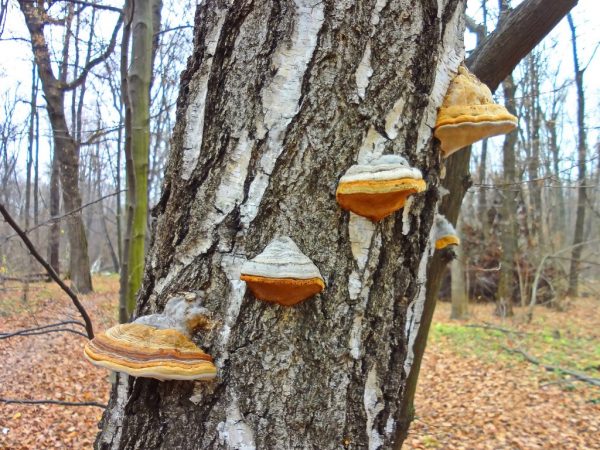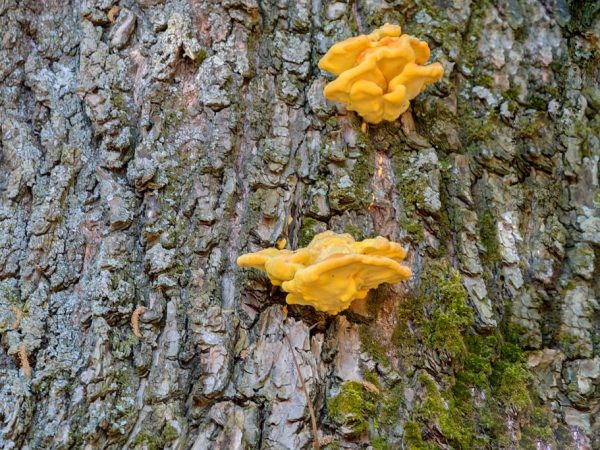Description of mushrooms growing on trees
Few mushroom pickers, going into the forest, pay attention to the mushrooms growing on the trees, because many of them are inedible. But there are also species worthy of our attention that have a wonderful aroma and excellent taste.

Description of mushrooms growing on trees
Curly griffin
Curly griffin is also known as ram mushroom. It is rarely found in nature, so few mushroom pickers know about its existence. Habitat - deciduous forests. At the same time, it grows on trunks with a wide leaf plate (maple, chestnut, oak, beech). These edible mushrooms appear on trees in late summer and early autumn. Fruit bodies can weigh between 5 and 10 kg.
Appearance
Like all woody mushrooms, curly griffin has a multilayer structure. The pulp is fleshy, light beige. The caps, of which the tree fungus has many, are flat and covered with a gray-white or beige dense skin. They are kept on a thin stem, the diameter of which does not exceed 2 cm. The inner side (hymenophore) of the ram mushroom is light. The edges of the caps are slightly wavy.
Beneficial features
This species is prized for its bactericidal properties. Even in ancient times, medicinal powder made from this fungus helped to cure tuberculosis. Today, folk healers of a number of regions where this mushroom is found make tinctures, decoctions, ointments and extracts on its basis.
Grifola holds the record for vitamin content. In addition to vitamins, it is rich in amino acids, minerals and trace elements, which allows it to be used even in traditional medicine.
Irina Selyutina (Biologist):
Grifola curly has the ability to partially inhibit the action of cyclooxygenase (enzymes found in various tissues of our body and exhibiting a different spectrum of sensitivity to aspirin-like drugs) and thus weaken the symptoms of inflammation and pain present, working like aspirin and ibuprofen.
It is useful for people with high blood cholesterol levels or disorders of the nervous system. Recommended for use in diabetes and cancer.
Cooking use
In terms of taste, the mushroom culture has a rich aroma and nutty notes in the taste. But, despite its good taste, it is rarely cooked. Only young specimens are used in cooking. In adults, the taste is much worse, and they can spoil any dish. You cannot use griffin in its raw form.
Chicken mushroom
The second name of the chicken mushroom is sulfur-yellow tinder fungus. Its peculiarity is that during heat treatment, not only a strong chicken smell appears, but also a characteristic taste. Many people who have given up eating meat include this product in their menu.And if a person is not warned of what the dish is made of, then he will be absolutely sure that chicken is present in the composition. It is especially appreciated by the Germans and Americans, who consider it a delicacy. It is found everywhere. Grows on the trunks of any crops, including garden crops. Fruiting throughout the summer.
The sulfur-yellow tinder fungus is a parasite. It, penetrating through damaged areas of the bark, destroys the tree on which it grows. An oak or maple braided by this parasitic species dies within 6-10 years.
Appearance
Mushroom pickers, who do not know about the existence of the sulfur-yellow tinder fungus, are repulsed by its appearance. The hat and body of this species are colored yellow. In young mushrooms, it is especially rich. Because of this, it is mistaken for poisonous. The body is represented by thin hyphae (filaments) that are tightly intertwined.
Weight varies from 6 to 10 kg. The wavy edges of the caps, covered with a thick skin, are slightly curved inward. The inner side of the caps is colored beige and yellow and has a porous structure. The legs are narrowed towards the base, and have a diameter of 1.5-2.5 cm.
Beneficial features

Chicken Mushroom Normalizes Liver Function
The composition contains antibiotics. This allows it to be used to treat staphylococcal infections. It is also rich in resinous substances that help fight respiratory diseases and normalize liver function. The use of this variety is shown for those who have problems with the biliary tract. Nutritionists use in their practice means, which include an extract from mushrooms, to get rid of excess weight.
Cooking use
Refers to conditionally edible mushrooms. Only young mushrooms are suitable for consumption. Adult mushrooms growing on the bark of a tree are poisonous. Also, mulberry trees, parasitizing on poplars and willows, are not used in cooking. This is explained by the presence in the bark of these cultures of bitter substances that saturate the pulp of the parasite that has settled on them.
Oyster mushroom
Oyster mushroom is the most popular type of edible mushroom growing on trees. Today it is not only harvested in forests, but also grown on mushroom farms, but much less than common oyster mushroom. It grows equally well on tree trunks and stumps. They prefer oaks, elms and maples. Oyster mushroom begins to bear fruit in late spring, and ends in early autumn. You can see this mushroom on a tree throughout Russia and Ukraine.
Appearance
The caps are shaped like a funnel and very rarely have a flat shape. The skin is of medium thickness, beige, ocher or light brown in color. The color of the cap depends on age. Young mushrooms are colored beige, and old ones are colored light brown. In section, they are white or light brown. They grow in small groups. Their weight is, on average, 400 g. Sometimes it reaches 600-800 g.
Irina Selyutina (Biologist):
Oyster mushroom is characterized by the fact that the plates of its hymenophore go down far down the leg and turn into a ribbed pattern. They are narrow, usually white or cream colored. Often this mushroom is called and abundant oyster mushroom, tk. sometimes the mass of fruit bodies collected together can reach 1 kg.
The closest relative, and moreover, very common of this type of oyster mushroom, is also a cultivated species native to East Asia - lemon oyster mushroom.
Beneficial features
Their benefit lies in the fact that they normalize blood pressure and lower blood cholesterol levels, have a beneficial effect on the condition of the skin, nails and hair. The medicinal properties of the mushroom help prevent the appearance of gastrointestinal diseases, stimulate the brain and strengthen the immune system. Not contraindicated for allergy sufferers and are able to remove toxins from the body.
Cooking use
Oyster mushrooms are used for cooking stews, soups, frying and stewing.The dense pulp has a pronounced mushroom aroma. The large amount of chitin present in the pulp requires careful and lengthy processing. The heat treatment time for young mushrooms is 20 minutes, and for old ones - 30-45 minutes.
Scaly polypore
This is another representative of the group of conditionally edible mushrooms. The people call it a hare, motley or elm tree. They appear on weak and diseased deciduous trees. A feature of scaly polypores is that they can grow singly, although most often in small groups. These mushrooms grow on walnut trees, oaks, lindens and maples. In addition, it is a mushroom that affects fruit crops. They prefer a warm climate, which is why they are more common in the southern regions. They grow well both in the forest and in the city. In parks they settle mainly on hazel trees. Fruiting from late spring to late summer.
Appearance
They have a large fruiting body. The diameter of the cap varies from 15 to 40 cm. In young elm trees, the cap is shaped like a kidney. Over time, it becomes flat. The cap is painted yellow, there are scales, as evidenced by the name. They are colored light brown or brown. Closer to the center, the scales are larger and darker. Scales are also present on the leg. The lower part of the cap has a tubular structure. The pulp has a pleasant mushroom aroma
Beneficial features

The mushroom is used for medicinal purposes
The medicinal properties allow them to be used in pharmaceuticals. They are part of medicines that are used for poisoning with various poisons. They are also part of ointments for nail fungus. In folk medicine, scaly tinder fungi are used to prepare remedies that help fight pathogenic fungi.
Cooking use
The elm tree is practically not used in cooking. Dishes should be prepared only from young specimens with juicy flesh. As it ages, it becomes tough and loses its flavor. These mushrooms are soaked before cooking. The duration of the heat treatment is 40-50 minutes.
Boletus mushrooms that grow near birch groves and honey mushrooms growing under the aspen are also edible. Even novice mushroom pickers are familiar with their description. Growing boletus or honey agarics cannot be seen on the bark. They feed on the roots of the host plant.
Differences between edible and poisonous
Poisonous mushrooms grow on trees more often than edible ones. Inedible mushrooms can be distinguished by several characteristics:
- many inedible mushrooms have a large cap;
- the cap and flesh of inedible ones are often red or brown in color (in the dangerous southern Ganoderma, for example, the flesh is colored dark red);
- in many species that are not suitable for consumption, the leg is either absent or has a miniature size. And the hats are more like growths.
If the species is not known to be edible or inedible, it should not be taken by hand.
Some cause huge damage to forestry. A striking representative is the spruce tinder fungus. It parasitizes on the body of coniferous crops. Its cap is dark purple (reminiscent of the color of blackberries), and the inner side (hymenophore) is orange or brown.
The effect of fungi on trees
All fungi growing on trees are parasites and have a negative effect on the condition of the tree. As a result of this relationship, trees die. If plants in the garden are affected, they must be disposed of immediately. Some summer residents believe that it is enough to cut the affected branch and get rid of the dry branches that have already died. But this is not enough, because mushroom spores quickly spread and fall under the bark of trees. They can also be carried by the wind from one plant to another. Spores ripen in most species by the beginning of autumn. It is necessary to destroy the affected and dead branches before this time. Otherwise, the spores, once on the bark, form a mycelium, from which mushrooms will grow.But, not necessarily in the same year. The mycelium sometimes develops inside the trunk for 2-4 years.
The interaction of the affected tree and healthy plants should be minimized. The cut branches are burned. If you want to breed edible tinder fungus or honey mushrooms, then it is better to grow them on stumps.
The exception is the species growing nearby tree crops. During their growth, the root system of the tree is entwined with hyphae. It doesn't harm him. It shares carbon nutrition with the fungi, and in return receives water and minerals, which are well absorbed from the soil by the hyphae. This type of relationship is called mycorrhiza. Plant residues for them are also a good source of nutrition for another group of fungi - saprophytes.
Conclusion
Many mushrooms grow on trees, but few are edible. In addition, all are parasites and have a destructive effect on the trunk and roots. Edible species are easier to grow with your own hands. So that they do not have a detrimental effect on healthy trees, it is better to do this on stumps or in special soil. But, from crops growing on the bark, one should not expect that their taste will be the same as that of other species. Porcini mushrooms or champignons, which can also be grown by hand, have a richer aroma.



